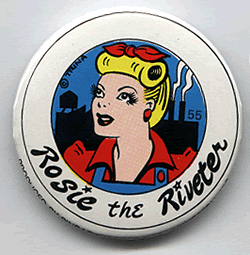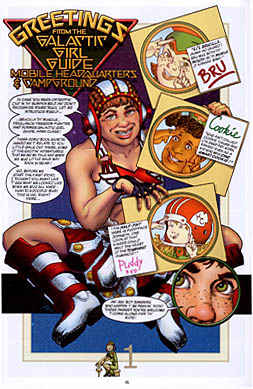I've read more histories of comics than some folks have had hot breakfasts. The books all have their errors and omissions, some better than others. But there's been a gradual sophistication of the study, to the point we are now at, where a sufficient body of research has accumulated that it's beginning to take cohesive form. This results in a sort of canon of accepted notions, things taken as verbatim and rarely questioned outside academia.
Enter
The Comic Book History of Comics.
A history done in comic book format. Nice. This has been appearing sporadically in single issue format over the last few years. I used the first two issues, covering Bronze and early Golden Ages, as a text in my Comic Book History class shortly after they came out. I was frustrated by the books' arriving three months after they were ordered(!), making them fundamentally useless for aiding in that portion of the course.
Now, however, there's a spiffy, gosh-wow no-sarcasm-intended really cool collected edition of this, from our friends at
IDW Publishing, who have been doing some wonderful work, both with new comics and with reprints - would that I had the funds for any of their
Artist's Edition series - and publishing this as a collection continues that trend.
I will be using this for a textbook in Comic History class, now that it's available in a decent uniform edition, if I get the opportunity.
However, it's not without its flaws. I list these while recognizing that the creators of the book have requested notification of errors and omissions, for correction in future volumes. However, I wrote them about a couple of the things I'm discussing here prior to the work being collected, and the errors I wrote about are still there.
The first line of the first (disclaimer) text page reads, "
this comic book is a work of historical scholarship."
Really?
Then where's the index?
Scholarship on history implies use as reference. You'd think an index would be a no-brainer. In fairness, the book does include a decent section of
Notes on Sources, with more on the book's web page, which is always a useful tool in research and citation.
There are some other problems here. Right off the bat, Fred van Lente (writer) and Ryan Dunlavey (artist) jump in with the Yellow Kid's 1896 debut in
Hogan's Alley, citing it as the first comic strip. This completely ignores
Ally Sloper's Half Holiday, a British strip that began in 1874.
I'm not going to pick the book apart page by page. Most of it is quite good, if a little heavy on the sarcasm and snark for my taste.
But there are some omissions and factual errors that are too glaring to ignore.
The
coup d'etat involving Major Malcolm Wheeler-Nicholson being underhandedly bought out by Harry Dondenfeld and Jack Liebowicz, covered in depth in
Geeks, Guns and Gangsters and in Larry Tye's recent volume
Superman, is reduced to one line on page 32. Since these events lead directly to the formation of DC Comics as we now know it (and are exacerbated by a Wheeler-Nicholson story appearing in A
ction Comics no.1, the book being discussed herein), it does deserve more than one line, especially a line that dismisses all the nuance of the facts.
Similarly, although The Shield is shown on page 58, there's no mention of his creation predating that of Captain America. Indeed, The Shield isn't even mentioned by name. This pattern recurs in other parts of the book. Cheech Wizard appears on page 206, inexplicably in a section on the early 1990s speculation market (which, given that Cheech is something of huckster, is somewhat apropos), but neither Cheech nor his creator Vaughn Bode' are mentioned in the section on undergrounds.
In fact, the entire New York underground scene is only mentioned,and the Comix from Wisconsin's Kitchen Sink Press and the Chicago underground scene are ignored.
The discussion of Wertham and the Comics Code is accurate as far as it goes, but it leaves out the Code's two major precursors: The Association of Comic Magazine Publishers Code of 1948 (which also had a seal used on covers!), and the in-house editorial code of Fawcett Comics, shown in Chip Kidd's book
SHAZAM!
The section on graphic novels mentions the early work of Lynd Ward and Franz Maesreel but neglects Milt Gross's 1930 classic He Done Her Wrong, in print from Fantagraphics. But Sabre, a graphic novel from Eclipse, Sabre, whose publication predates that of A Contract With God (albeit only by a few months) is ignored.
They do manage to cite Gil Kane's Blackmark and His Name is Savage in this context, and rightly so, along with the 1950 It Rhymes With Lust. However, the followup paperback The Case of the Winking Buddha, is overlooked. In fairness, the latter work is of lesser quality, but we're talking history here, not aesthetics.
Some of these things might seem a tad nit-picky. Maybe so. They're significant to me, but not necessarily to the average reader. Still if this is the average reader's first exposure to comics history, that reader might take these things as Gospel unquestioningly.
But the most glaring error is almost an insult.
There are no female creators mentioned in the entire book. Not one.
I usually don't do the big text thing, but it seems correct to do so here.
No mention of Lily Renee', Marie Severin, Ramona Fradon, Lee Mars, Colleen Doran, Jan Duuresema, Trina Robbins, Shelby Sampson, Alison Bechdel, Mary Wings, Roberta Gregory, Selby Kelly, or the great neglected Shary Fleniken, whose work was in at least one of the Air Pirates books, though she wasn't named in the suit.
And that list was just off the top of my head. There are so many more that could be recognized, especially in the last 30 years.
The only mention of women cartoonists in the entire book is in the section on romance comics, page 60: "Though through our allegedly more enlightened "modern" eyes, romance comics may be seen as simply re-inscribing the more patriarchal aspects of American society (as 99.99% of them were written and drawn by men)..."
That's it. A backhanded acknowledgment of the supposed .01% of comic artists and writers of the 1940s who were female. That's the whole of the discussion of female creators of comics in this history.
Again, that doesn't invalidate the book. Neither does it make the book inherently bad. It's mostly really good. What is here is reasonably well-researched and presented in an entertaining (if often drenched in fanboy attitude ) fashion.
I will use this as a text, but I will expect my students to pore over it with a microscope.
No history of anything can be perfect, but this one has a few really big holes.





















